
The DS1 Fractional Group, DS1/E1 MIB
The DS1 Fractional group consists of the DS1 fractional table. This table (dsx1FracTable) is fully supported by the E1 DSU/CSU and allows channel (time slots) to be mapped between the E1 interfaces and data ports. If an invalid channel map (e.g., two interfaces mapped to a single time slot, one interface mapped to two E1s, etc.) is received, an error is returned to the SNMP manager. The E1 DSU/CSU validates all channel configurations before applying them.
Operational Note: The fractional E1 group only allows specification of an entire interface to a particular time slot on another interface (i.e., a time slot on one interface cannot be mapped to a time slot on another interface). This prevents complete mapping of time slots on the DTE Drop/Insert interface to time slots on the network E1 interface. For mapping time slots between the network and DTE E1 interfaces, the following convention is used: Time slots on the E1 interface that are mapped to another E1 interface (i.e., not a data port) are connected in ascending order. For example, if the fractional table for the network E1 interface maps
When
RS-232-like MIB (RFC 1317)
The ªrs232º object defined by RFC 1317 is supported for all of the synchronous data ports, the COM port, and the AUX port. The
•Number of
•The General Port Table
•The Asynchronous Port Table
•The Synchronous Port Table
•The Input Signal Table
•The Output Signal Table
The Asynchronous Port table is not supported by the
E1 DSU/CSU for the synchronous data ports. The Input Signal and Output Signal tables are not supported for the AUX and COM ports. The following sections provide clarification for objects contained in the
Number of Ports ± ªrs232Numberº Object (rs232 1)
This object contains the number of ports in the
General Port Table, RS-232-like MIB
The general port table contains general configuration objects for the
General Port Table ± ªrs232PortIndexº Object (rs232PortEntry 1)
This object contains a unique value for each port and is used as an index into the general port table (rs232PortTable). The values of the rs232PortIndex object vary between models and are listed below.
The values of rs232PortIndex for the 3172 DSU/CSU are:
•1 ± COM port
•2 ± Auxiliary
•3 ± DCE port 1
•4 ± DCE port 2
The values of rs232PortIndex for the 3174 DSU/CSU are:
•1 ± COM port
•2 ± Auxiliary
•3 ± DCE port 1
•4 ± DCE port 2
•5 ± DCE port 3
•6 ± DCE port 4
December 1996 |
